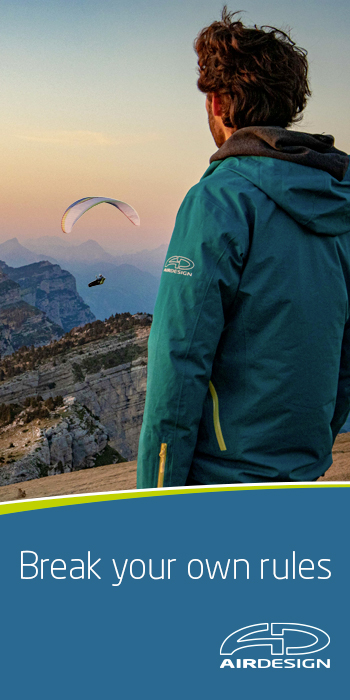TIPS ON HOW TO BECOME A BETTER PILOT!
Paragliding Master Tips are a series of articles designed to improve existing skills and techniques as well as help learn new ones. Intended for the beginner to intermediate pilot, these tips and tricks are offered as guidelines from some of paragliding’s most knowledgeable pilots.
Emma Casanova

3 – The reverse launch
Getting to grips with the reverse launch technique will require time and effort to master.
Launch areas can be stressful but this is too is something we can master by eliminating negative thoughts and feelings and adopting a “can-do” attitude, which will in turn develop into self-confidence.
By taking a good look around launch and making mental notes of the conditions, your surroundings, any hazards or danger areas, we can calmly rehearse in our minds what we are about to do in a positive way.
Mads Syndergaard dedicates a whole chapter to it in his book, “Flying Rags for Glory”, calling it the “priming” of the mind. The “priming” is just as much part of learning a new skill as actually performing it because it affects your mind in a positive way. Even though care should still be taken to ensure you don’t end up overriding your confidence and ability, positive thinking does lead to achievement.
Remember that whilst launch is not always the best place to practice, it is vital to get to grips with a sure-footed reverse launch technique. Find an open field and just keep practising again and again until you get it right.
Emma Casanova reports
The launch
If ever there was a time to think positively and be committed, this is it!
We have all witnessed fluffed launches attempts; failings through either lack of commitment or a poor technique. It is true that reverse launching can be difficult, even intimidating, but just like with any other skill it can be learnt so that it becomes second nature. Think about how great it would feel to rock up to launch on a strong day, lay your glider out and take off without any hesitation.
In the Master Tips series No. 2, we learnt that glider preparation and building a wall is the key to a good symmetrical inflation. We also talked about holding the risers using the “crossed-hands” technique, which is vital throughout the entire inflation procedure, and, as we also sometimes see, without letting go of the brakes!
The continuous fluid motion of the reverse launch technique ensures that we remain in control of our glider throughout, even if we become airborne before having had time to turn into wind. There exists several other launch techniques that enable the pilot to have the brakes in the correct hands, but the “cross-hands” technique is the only one that does not have a negative impact on the glider

Prepare to launch
The first and very important thing to establish is the direction you will want to turn; once you’ve made up your mind, don’t ever change it. A great tip I was once given was this: if you get confused on launch, look down at your hands holding the risers. Whichever riser is on the top, this will be your turn direction. I.e. if the left riser is ontop of the right riser you will be turning to the left to take off.
Now, build a perfect wall with your glider; the brake lines must have a clear run through the pulleys to the canopy, and your body must be square on to the wing. If necessary, lower your centre of gravity by bending your knees slightly. x

Once your symmetrical wall is built and you have made your pre-flight checks, transfer your hands to the appropriate brake handles and A-risers/A-lines. Some gliders have split A-risers however most modern gliders are launched using only the centre A-lines. This helps inflate the glider from the middle whilst preventing the wingtips coming up faster than the rest of the canopy.
Now, have a quick look down at your hands and make sure your wrists and forearms are completely crossed one over the other using the “cross-over” technique. You are now ready to inflate the wing.

This is where the movements should all flow together in one graceful and committed manoeuvre. At this point, it is imperative that your shoulders stay parallel to the wing. Turning one shoulder or the other will have an effect on the riser lengths, by shortening or lengthening one side or the other, which will consequentially bring up the glider asymmetrically. (Photo C)
The strength and timing of your inputs on the different controls of the glider will be governed by several factors: the wind speed, how thermic the air is on launch and the type of glider you are launching. However, the ideal position to initiate the inflation is a well-balanced pilot with knees slightly bent, who can lean slightly forward then back on to one foot whilst exerting tension on the risers. (Photo D)
Simultaneously lift your hands up whilst “flicking” your wrists upwards and the wing will begin to inflate and rise in an arc shape. You now need to exert a certain amount of resistance to the horizontal pulling force of the wing to keep the lines tensioned whilst also moving yourself under the rising canopy. If there is too much resistance the wing will rise too quickly above you and may lift then dump you on the ground; too little resistance will mean you are pulled toward the glider before it rises, or the wing may not want to rise at all.

By practising the different pressures to each control, you will know how much resistance to apply taking into the wind speed and the air, and by using he “crossed-hands” technique, you will be able steer your wing on its way up by pulling slightly more on one side or the other to keep the canopy symmetrical.
Just before the wing reaches its highest point above your head, you may need to apply some break to stop it from overflying. Whilst the glider is in this position, it’s also a good time to check that all of the lines are clear before taking-off. (photo E) At this point if the wing has not come up cleanly, drop it back down and start again. It is far safer and easier than struggling when you are not in control.
Throughout the manoeuvre, make sure the lines are tensioned so that the wing does not “unload” and collapse. At this point you should have complete ontrol of your glider and even be able to keep it hovering above your head. Once you have made a final visual check that the lines are clear, you can turn and continue to take off.

Keep the pressure on by leaning your full body weight low and forwards through the rises and make sure that before you are about to take off, you are flying the glider at maximum trim speed, in the right direction. (Photo F) Speed is crucial whether you are taking off in windy conditions or calmer air. Your glider must be fully loaded with positive pressure through the brakes all the time to prevent the glider over-flying.

Photo : Andy Stocker
Troubleshooting
The glider does not lift off the ground
You need to introduce air into the cells through the leading edge so when holding the middle A-lines or A-risers in each hand, try to be more assertive when flicking your wrists upwards, whilst simultaneously rocking your body firmly back onto one foot to inflate the glider.
The glider rises off the ground but with too much speed
There may be a strong wing on launch so once the glider starts to rise, be ready to brake it sharply before it reaches more than 80%. Get ready to run under the glider and be assertive with the brakes downwards and outwards to stop the glider lifting you off the ground. Lean backwards against the lines with your full weight and bend you knees.
You are getting dragged towards your glider whilst the canopy is rising in an arc
The wind may be too strong, in which case, take time out and wait for the wind to drop before trying again.
You could try using only the centre A-lines and, with your hands through the brakes, use the rear risers to slow the glider’s ascent, which will take much of the energy out of the wing giving you time to walk under it whilst leaning back against the line tension. Once the glider is almost at it’s zenith, release and A’s and apply firm pressure with the brakes to stop to the canopy over flying you.
The glider feels floppy
Make sure that before you turn to make your take-off run, your glider is checked and and above your head. There needs to be tension so that when you turn, you are flying directly into wind and the glider is at trim speed. There needs to be positive pressure on the wing all the time and this is created by leaning forwards through the risers. If you are taking off too slowly, the glider will feel floppy with little or no feeling in the risers and brakes. Sometimes you can see pilots using short, “trotting” steps whilst applying too much brake pressure, which prevents the glider from loading with air. It is crucial to remember that you need to take-off at trim speed, with your hands up, whether it is windy or not, so really lean forward into wind with conviction before you take-off.
Practice to impress
A good technique to practice is the actual “turn”. When your glider is almost overhead, turn to face the wind as if you were going to launch but this time, keep the glider above your head. To do this, you will need to use your body to keep the glider pressured against the force of the wind, and bend your knees to give you a better centre of gravity. By applying small but firm pressure on the brakes, you can feel the movement of the glider from right to left, forwards and backwards. Look up at the canopy so that you can anticipate which command to use at the moment you need to react. Very often pilot input is lagging, with the glider already off centre before any input has been. With bent knees and gentle brake pressure, use your senses to “feel” how symmetric the wing is above your head. When you are confident, you can practice walking a figure of 8 whilst being in perfect control of the canopy. This is an impressive example of glider control, it not only looks good, but it feel great too!


